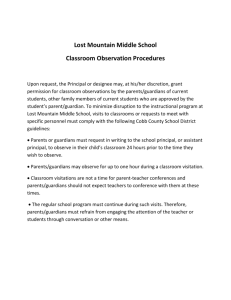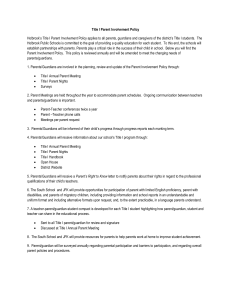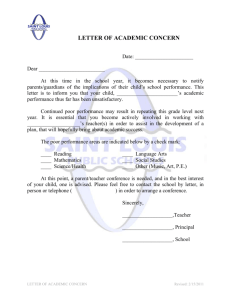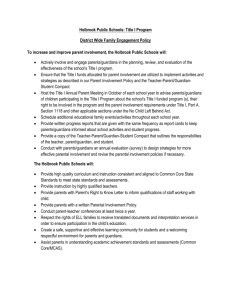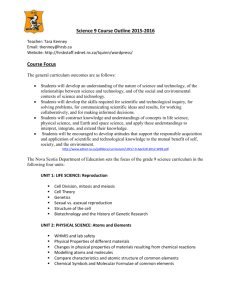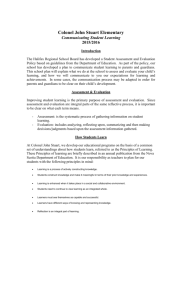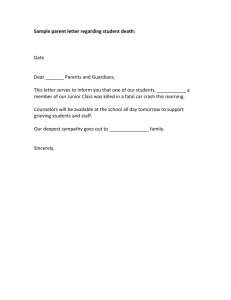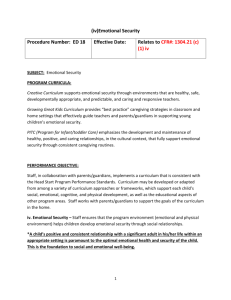Plan for Communication Student Learning
advertisement
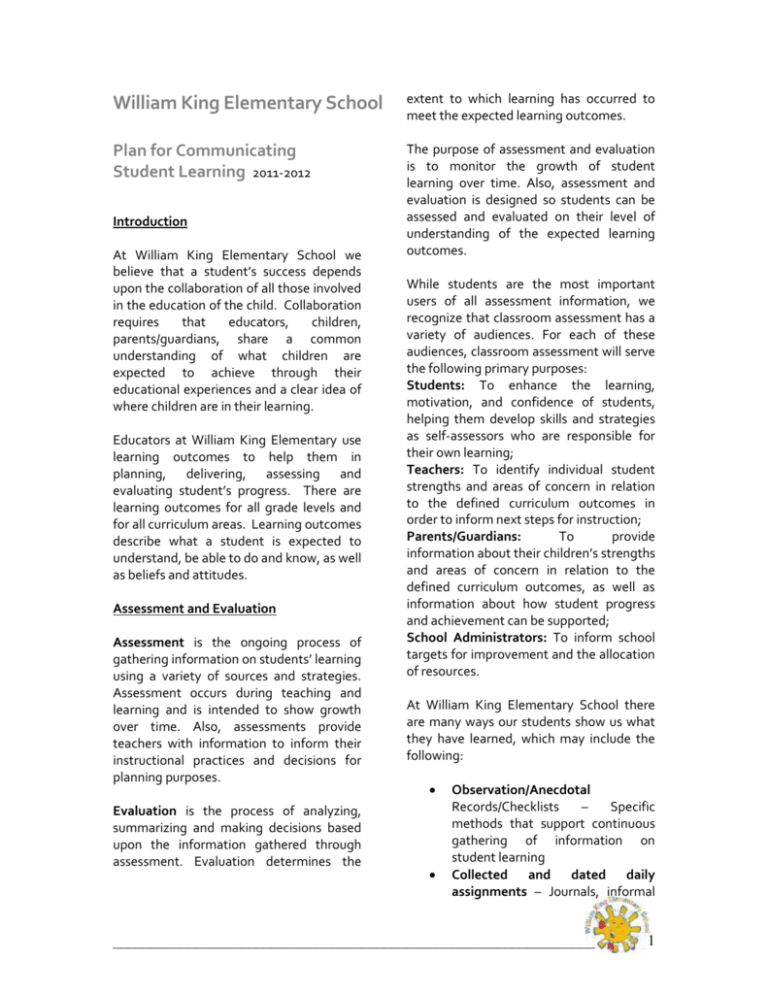
William King Elementary School extent to which learning has occurred to meet the expected learning outcomes. Plan for Communicating Student Learning 2011-2012 The purpose of assessment and evaluation is to monitor the growth of student learning over time. Also, assessment and evaluation is designed so students can be assessed and evaluated on their level of understanding of the expected learning outcomes. Introduction At William King Elementary School we believe that a student’s success depends upon the collaboration of all those involved in the education of the child. Collaboration requires that educators, children, parents/guardians, share a common understanding of what children are expected to achieve through their educational experiences and a clear idea of where children are in their learning. Educators at William King Elementary use learning outcomes to help them in planning, delivering, assessing and evaluating student’s progress. There are learning outcomes for all grade levels and for all curriculum areas. Learning outcomes describe what a student is expected to understand, be able to do and know, as well as beliefs and attitudes. Assessment and Evaluation Assessment is the ongoing process of gathering information on students’ learning using a variety of sources and strategies. Assessment occurs during teaching and learning and is intended to show growth over time. Also, assessments provide teachers with information to inform their instructional practices and decisions for planning purposes. Evaluation is the process of analyzing, summarizing and making decisions based upon the information gathered through assessment. Evaluation determines the While students are the most important users of all assessment information, we recognize that classroom assessment has a variety of audiences. For each of these audiences, classroom assessment will serve the following primary purposes: Students: To enhance the learning, motivation, and confidence of students, helping them develop skills and strategies as self-assessors who are responsible for their own learning; Teachers: To identify individual student strengths and areas of concern in relation to the defined curriculum outcomes in order to inform next steps for instruction; Parents/Guardians: To provide information about their children’s strengths and areas of concern in relation to the defined curriculum outcomes, as well as information about how student progress and achievement can be supported; School Administrators: To inform school targets for improvement and the allocation of resources. At William King Elementary School there are many ways our students show us what they have learned, which may include the following: Observation/Anecdotal Records/Checklists – Specific methods that support continuous gathering of information on student learning Collected and dated daily assignments – Journals, informal ________________________________________________________________ 1 writing shared among students and teachers Other ways of representing – Concept maps, drama, puppet shows, dioramas and skits Reports/Projects/Presentations – Assignments extending over a period of time demonstrating their understanding of a concept or topic Observation Survey – Structured assessment activities giving evidence of the child’s reading/writing abilities Running Records – Method used to record and analyze a student’s oral reading strategies Conferences/Interviews – Discussions between students and teachers regarding a student’s accomplishments Tests/Quizzes – A culmination of the expected learning outcomes through written, oral or demonstration activities Performances – Skits, puppet shows, public speaking, debates, plays, role playing, reader’s theatre, singing and dance, instrumental music, visual arts and athletics Peer and Self Evaluation – Students assessing their own work as well as their classmate’s work using clear guidelines Portfolios – A collection of student/teacher selected work that portrays a student’s effort, progress and achievement over a period of time Models – Two or three dimensional representation or construction Rubrics – Identify criteria for creating a project and provide indicators to judge each student’s performance. what they know. It is important for teachers to share assessment information with students and parents so success can be celebrated and challenges be addressed. Communicating Student Learning to Parents At William King Elementary School parents/guardians will be informed of student learning in a variety of ways; some on a school wide basis and others particular to individual classes and teachers. These include but are not limited to: Report Cards Parent/Teacher Interviews Student led conferences School Assemblies/Special Events Curriculum Night Evening Assemblies (Math/Literacy evening) Holiday Concerts Student-Led Activities Drama performances School Newsletters Agenda Books (2 way communication) Email/Phone calls Home Reading Program Program Planning Meetings Work Displays/ Projects/ Bulletin Boards Please refer to the William King website (http://wkes.ednet.ns.ca) and/or the Halifax Regional School Board’s Academic Calendar (www.hrsb.ns.ca) for further information. Parents/Guardians wishing to review the relevant provincial curriculum guides may borrow a copy from the school or access them through the government website (http://doc-depot.ednet.ns.ca). It is our belief that children should be given multiple opportunities to demonstrate ________________________________________________________________ 2 Parent Concern Protocol While every effort is made to treat student’s fairly and to communicate clearly, there will be occasions when a student, parent/guardian may have a concern they wish to address. Students or parents/guardians should follow the Board’s Parent Concern Protocol and contact the teacher regarding concerns about some aspect of the curriculum or the child’s progress. The teacher will respond to this communication within a reasonable time. If the student, teacher(s), parents/guardians feel that the participation of the Principal would help bring about a satisfactory resolution, the Principal will meet with all involved after initial contact with the teacher has been made. The goal is to resolve the issues in a climate of mutual respect keeping in mind the best interest of the child. Parents/guardians are invited to meet with the teachers by appointment by calling the school at 479-4200 or contact them through email. Staff email addresses are listed on the school website http://wkes.ednet.ns.ca Children Requiring Additional Support as having special needs, a referral is made to the school planning team. The school planning team consists of the Principal, Vice Principal, Psychologist, Resource Teacher(s), Learning Center Teacher, Classroom Teachers, and other school personnel as needed. Parents/guardians are consulted and written permission is required for any formal individual assessment. Parents/guardians are informed of assessment results. These results, along with other information, will be used in making adaptations or modifications to the student’s program or developing an Individual Program Plan (IPP) for the student. Parents/guardians will be invited to ‘program planning meetings’. To ensure that every child receives the best possible programming it is essential to have as much information as possible from all the adults involved with a child’s education. Please take an active role in your child’s learning. We welcome and recommend that you contact teachers and/or the school if you have questions and/or would like to inquire about your child’s learning. Let’s work together to ensure success for every child! William King Elementary is committed to supporting the learning of all students. The early identification of students requiring extra support is the most effective approach in meeting their needs. Parents/guardians are informed before any intervention such as Resource and/or Learning Center support takes place. The school has established a process for the identification, assessment and program planning for students with special needs. Classroom teachers, resource teachers and parents/guardians may initiate and/or assist in identifying students with special needs. In some cases when a student is identified ________________________________________________________________ 3
